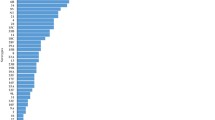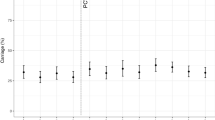Abstract
The introduction of a pneumococcal conjugate vaccine in Venezuela needs previous studies to assess vaccine efficiency. We conducted a survey of nasopharyngeal pneumococcal carriage in urban children in Caracas and studied the distribution of serotypes. We compared these data with survey data available for invasive strains isolated in the same area and in the same time period. An overall pneumococcal carriage rate of 27% was observed. The most predominant capsular serotypes among carriage isolates were 6B (29%), 19A (13.8%), 23F (10%), 14 (8.3%), 6A (8.3%) and 15B/C (3.3%) and among invasive isolates 6B (25%), 14 (15%), and 19A, 6A, 7F, and 18 (7.5% each). The serotypes/groups 1, 5, 7F and 18, jointly covering 30% of the invasive strains, represented less than 0.7% of the carrier strains. The theoretical coverage of the pneumococcal conjugate vaccine PCV13 for carriage and invasive strains was calculated to be 74% and 90%, respectively. Our study demonstrates important differences for the serotype distribution in disease and carriage isolates and provides a key baseline for future studies addressing the prevalence and replacement of invasive and carriage serotypes after the introduction of the PCV 13 vaccine in Venezuela in the year 2010.


Similar content being viewed by others
References
Bogaert D, De Groot R, Hermans PW (2004) Streptococcus pneumoniae colonisation: the key to pneumococcal disease. Lancet Infect Dis 4(3):144–154
Gray BM, Converse GM 3rd, Dillon HC Jr (1980) Epidemiologic studies of Streptococcus pneumoniae in infants: acquisition, carriage, and infection during the first 24 months of life. J Infect Dis 142(6):923–933
Hausdorff WP, Bryant J, Kloek C, Paradiso PR, Siber GR (2000) The contribution of specific pneumococcal serogroups to different disease manifestations: implications for conjugate vaccine formulation and use, part II. Clin Infect Dis 30(1):122–140
Mastro TD, Nomani NK, Ishaq Z, Ghafoor A, Shaukat NF, Esko E, Leinonen M, Henrichsen J, Breiman RF, Schwartz B et al (1993) Use of nasopharyngeal isolates of Streptococcus pneumoniae and Haemophilus influenzae from children in Pakistan for surveillance for antimicrobial resistance. Pediatr Infect Dis J 12(10):824–830
Lehmann D, Gratten M, Montgomery J (1997) Susceptibility of pneumococcal carriage isolates to penicillin provides a conservative estimate of susceptibility of invasive pneumococci. Pediatr Infect Dis J 16(3):297–305
Berezin EN, Cardenuto MD, Ferreira LL, Otsuka M, Guerra ML, Brandileone MC (2007) Distribution of Streptococcus pneumoniae serotypes in nasopharyngeal carriage and in invasive pneumococcal disease in Sao Paulo, Brazil. Pediatr Infect Dis J 26 (7):643–645. doi:10.1097/INF.0b013e3180616d0f00006454-200707000-00019
Lauderdale TL, Wagener MM, Lin HM, Huang IF, Lee WY, Hseih KS, Lai JF, Chiou CC (2006) Serotype and antimicrobial resistance patterns of Streptococcus pneumoniae isolated from Taiwanese children: comparison of nasopharyngeal and clinical isolates. Diagn Microbiol Infect Dis 56 (4):421–426. doi:10.1016/j.diagmicrobio.2006.06.006
Hausdorff WP, Feikin DR, Klugman KP (2005) Epidemiological differences among pneumococcal serotypes. Lancet Infect Dis 5(2):83–93
CLSI (2008) Performance standards for antimicrobial susceptibility testing; Eighteenth informational supplement. CLSI Document M100-S18. Clinical and Laboratory Standards Institute, Wayne, PA
Pai R, Gertz RE, Beall B (2006) Sequential multiplex PCR approach for determining capsular serotypes of Streptococcus pneumoniae isolates. J Clin Microbiol 44(1):124–131
Carvalho Mda G, Pimenta FC, Gertz RE, Jr., Joshi HH, Trujillo AA, Keys LE, Findley J, Moura IS, Park IH, Hollingshead SK, Pilishvili T, Whitney CG, Nahm MH, Beall BW (2009) PCR-based quantitation and clonal diversity of the current prevalent invasive serogroup 6 pneumococcal serotype, 6 C, in the United States in 1999 and 2006 to 2007. J Clin Microbiol 47 (3):554–559. doi:10.1128/JCM.01919-08
OPS (2008) Informe Regional de SIREVA II, 2007. Datos por país y por grupos de edad sobre las características de los aislamientos de Streptococcus pneumoniae, Haemophilus influenzae y Neisseria meningitidis, en procesos invasores. Documentos Tecnicos. Tecnologías Esenciales de Salud. THR/EV- 2008/001
Brueggemann AB, Griffiths DT, Meats E, Peto T, Crook DW, Spratt BG (2003) Clonal relationships between invasive and carriage Streptococcus pneumoniae and serotype- and clone-specific differences in invasive disease potential. J Infect Dis 187(9):1424–1432
Solorzano-Santos F, Ortiz-Ocampo LA, Miranda-Novales MG, Echaniz-Aviles G, Soto-Nogueron A, Guiscafre-Gallardo H (2005) Prevalence of Streptococcus pneumoniae serotypes on nasopharyngeal colonization in children of Mexico City. Salud Pública Méx 47(4):276–281
Laval CB, de Andrade AL, Pimenta FC, de Andrade JG, de Oliveira RM, Silva SA, de Lima EC, Fabio JL, Casagrande ST, Brandileone MC (2006) Serotypes of carriage and invasive isolates of Streptococcus pneumoniae in Brazilian children in the era of pneumococcal vaccines. Clin Microbiol Infect 12(1):50–55
Lagos RMA, San Martín O, Seoane M, Maldonado A, Hormazábal JC, Loyola H, Levine MM (2006) Nasopharyngeal (NP) carriage of Streptococcus pneumoniae (S.pn) in a cohort of healthy Chilean new born infants (NBI) followed from age 0 to 24 months (mos). Paper presented at the 5th international symposium on pneumococci and pneumococcal diseases (ISPPD5), Alice Springs, Australia
Rivera-Olivero IA, Bogaert D, Bello T, del Nogal B, Sluijter M, Hermans PW, de Waard JH (2007) Pneumococcal carriage among indigenous Warao children in Venezuela: serotypes, susceptibility patterns, and molecular epidemiology. Clin Infect Dis 45(11):1427–1434
Bogaert D, Engelen MN, Timmers-Reker AJ, Elzenaar KP, Peerbooms PG, Coutinho RA, de Groot R, Hermans PW (2001) Pneumococcal carriage in children in The Netherlands: a molecular epidemiological study. J Clin Microbiol 39(9):3316–3320
Spadola E, Fernandez S, Payares D, Tarazona B, Gabastou J, de Waard JH (2009) Distribucion de serotipos de Streptococcus pneumoniae causantes de enfermedad invasiva en niños menores de 5 años en Venezuela durante los años 1999–2007. Revista de Salud por los Niños de las Americas "SALUDARTE2 7(1):31–41
Porat N, Trefler R, Dagan R (2001) Persistence of two invasive Streptococcus pneumoniae clones of serotypes 1 and 5 in comparison to that of multiple clones of serotypes 6B and 23 F among children in southern Israel. J Clin Microbiol 39(5):1827–1832
Hausdorff WP, Bryant J, Paradiso PR, Siber GR (2000) Which pneumococcal serogroups cause the most invasive disease: implications for conjugate vaccine formulation and use, part I. Clin Infect Dis 30(1):100–121
Smith T, Lehmann D, Montgomery J, Gratten M, Riley ID, Alpers MP (1993) Acquisition and invasiveness of different serotypes of Streptococcus pneumoniae in young children. Epidemiol Infect 111(1):27–39
Pelton SI, Huot H, Finkelstein JA, Bishop CJ, Hsu KK, Kellenberg J, Huang SS, Goldstein R, Hanage WP (2007) Emergence of 19A as virulent and multidrug resistant pneumococcus in Massachusetts following universal immunization of infants with pneumococcal conjugate vaccine. Pediatr Infect Dis J 26 (6):468–472. doi:10.1097/INF.0b013e31803df9ca00006454-200706000-00003
Ardanuy C, Rolo D, Fenoll A, Tarrago D, Calatayud L, Linares J (2009) Emergence of a multidrug-resistant clone (ST320) among invasive serotype 19A pneumococci in Spain. J Antimicrob Chemother 64 (3):507–510. doi:10.1093/jac/dkp210
Camargos P, Fischer GB, Mocelin H, Dias C, Ruvinsky R (2006) Penicillin resistance and serotyping of Streptococcus pneumoniae in Latin America. Paediatr Respir Rev 7(3):209–214. doi:10.1016/j.prrv.2006.04.004
Agudelo CI, Castaneda E, Corso A, Regueira M, de Brandileone MC, Brandao AP, Maldonado A, Hormazabal JC, Tamargo I, Echaniz-Aviles G, Soto A, Viveros MG, Hernandez I, Chamorro G, Weiler N, Sanchez J, Feris JM, Camou T, Garcia G, Spadola E, Payares D, Gabastou JM, Di Fabio JL (2009) Resistance to non-beta-lactam antibiotics in the clinical isolates of Streptococcus pneumoniae of children in Latin America. SIREVA II, 2000–2005. Rev Panam Salud Pública 25(4):305–313
Acknowledgements
This study was financially supported by research grants 0887X1-8802 from Wyeth Venezuela CA. We are grateful to the pediatric department “Niños Sanos” of the Children Hospital JM de los Rios, Caracas, Venezuela, especially Dr. Anabela Fernandez and Dr. Yecenia Pérez, and also of the Tuberculosis Laboratory Xiomara Brito and Domingo Ramos for technical assistance. Both Ismar Rivera-Olivero and Berenice del Nogal are considered first authors.
Author information
Authors and Affiliations
Corresponding author
Rights and permissions
About this article
Cite this article
Rivera-Olivero, I.A., del Nogal, B., Sisco, M.C. et al. Carriage and invasive isolates of Streptococcus pneumoniae in Caracas, Venezuela: the relative invasiveness of serotypes and vaccine coverage. Eur J Clin Microbiol Infect Dis 30, 1489–1495 (2011). https://doi.org/10.1007/s10096-011-1247-5
Received:
Accepted:
Published:
Issue Date:
DOI: https://doi.org/10.1007/s10096-011-1247-5




